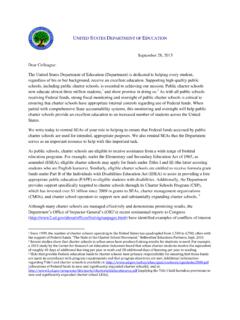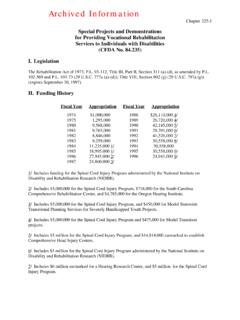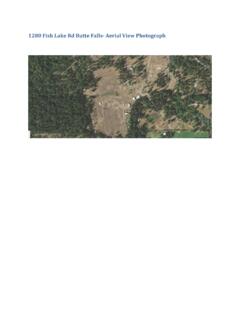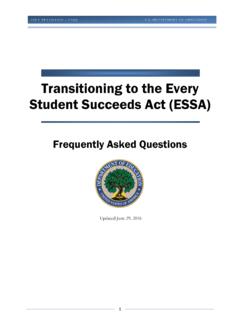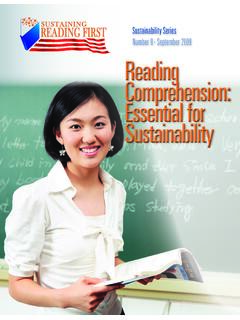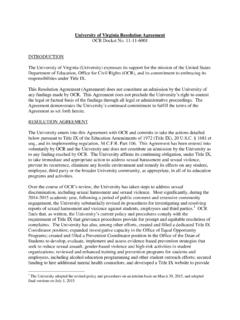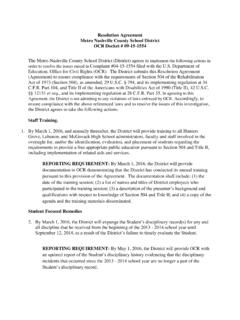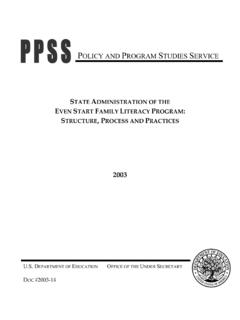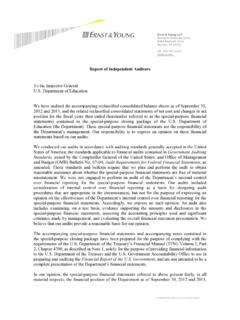Transcription of Archived: Comprehensive Needs Assessment (PDF)
1 Comprehensive Needs Assessment Comprehensive Needs Assessment Materials adapted from Planning and Conducting Needs Assessments: A Practical Guide (1995) Office of Migrant Education: 2001 New Directors Orientation 1 Archived Information Comprehensive Needs Assessment Summary of Foundation Concepts A need is a discrepancy or gap between what is and what should be. A Needs Assessment is a systematic set of procedures that are used to determine Needs , examine their nature and causes, and set priorities for future action. In the real world, there is never enough money to meet all Needs . Needs assessments are conducted to help program planners identify and select the right job before doing the job right. KEY TOPICS In this session, we will answer the following: What is a Needs Assessment ?
2 What steps are involved in conducting a Needs Assessment ? What aspects of a Needs Assessment are important to its success? Office of Migrant Education: 2001 New Directors Orientation 2 Comprehensive Needs Assessment Why Conduct a Needs Assessment ? Why do program planners in education, business, industry, government, etc. conduct Needs assessments? _____ Office of Migrant Education: 2001 New Directors Orientation 3 Comprehensive Needs Assessment Legal Requirements The law requires States to submit applications that describe: a Comprehensive plan for Needs Assessment and service delivery that identifies the special educational Needs of migrant children; how the State s priorities for the use of funds relate to the State s Needs Assessment ; and how the State will award subgrants to reflect the results of the Comprehensive Needs Assessment plan.
3 [See Section 1304 - State Applications; Services & Section 1306 - Comprehensive Needs Assessment and Service-Delivery; Authorized Activities.] Program Requirements Policy guidance issued by the Office of Migrant Education states that Needs assessments: are conducted annually; use the best information available; are a process by which each state determines how to integrate MEP-funded services into the state s Comprehensive education reform plan to best meet the identified Needs of migrant children; establish statewide priorities for local procedures; and provide a basis for the allocation of funds. Office of Migrant Education: 2001 New Directors Orientation 4trt It is not possible to succeed with a brillian idea and superb execution of the wrong John O Tool Author, Adveising Comprehensive Needs Assessment Office of Migrant Education: 2001 New Directors Orientation 5 Definition of Key Terms Knowing and not doingare equal to not knowing at all.
4 Anonymous Need refers to the gap or discrepancy between a present state (what is) and a desired state (what should be). The need is neither the present nor the future state; it is the gap between them. Desired Results -Current results = Need (What should be) (What is) 100% of third grade migrant students meet the state proficiency level in reading -30% of third grade migrant students meet the state proficiency level in reading = 70% of third grade migrant children must reach the proficiency level in reading Target Group Needs Assessments are focused on particular target groups in a system. Common target groups in education settings include students, parents, teachers, administrators, and the community at-large. Ideally, Needs assessments are initially conducted to determine the Needs of the people ( , service receivers) for whom the organization or system exists ( , students).
5 However, a Comprehensive Needs Assessment often takes into account Needs identified in other parts of a system. For example, a Needs Assessment might include the concerns of the service providers ( teachers, guidance counselors, or school principals the people who have a direct relationship with the service receivers) or system issues ( , availability of programs, services, and personnel; level of program coordination; and access to appropriate facilities). Comprehensive Needs Assessment Definition of Key Terms (continued) A Needs Assessment is a systematic approach that progresses through a defined series of phases. Needs Assessment focuses on the ends ( , outcomes) to be attained, rather than the means ( , process). For example, reading achievement is an outcome whereas reading instruction is a means toward that end.
6 It gathers data by means of established procedures and methods designed for specific purposes. The kinds and scope of methods are selected to fit the purposes and context of the Needs Assessment . Needs Assessment sets priorities and determines criteria for solutions so that planners and managers can make sound decisions. Needs Assessment sets criteria for determining how best to allocate available money, people, facilities, and other resources. Needs Assessment leads to action that will improve programs, services, organizational structure and operations, or a combination of these elements. ttA system is a set of regularlyinteracting elements that form aunified whole and organized for acommon important characteristic of asystem is tha all parts areinterdependent.
7 Anything thaaffects one part of the system hasconsequences for the of Migrant Education: 2001 New Directors Orientation 6 Comprehensive Needs Assessment A Three-Phase Model of Needs Assessment ..a systematic approach that progresses through a defined series of phases Prepare a Management Plan Identify Concerns Determine Measurable Indicators Consider Data Sources Decide Preliminary Priorities Determine Target Groups Gather Data to Define Needs Prioritize Needs Identify & Analyze Causes Summarize Findings Set Priority Needs Identify Possible Solutions Select Solution Strategies Propose Action Plan Prepare Report III Make Decisions II Gather & Analyze DataI Explore What Is Office of Migrant Education: 2001 New Directors Orientation 7 Comprehensive Needs Assessment Office of Migrant Education.
8 2001 New Directors Orientation 8 III Make Decisions II Gather & Analyze DataI Explore What Is Decide Preliminary Priorities Identify Major Concerns Consider Data Sources Determine Need Indicators The purpose of Phase I is to investigate what is already known about the Needs of the target group; to determine the focus and scope of the Needs Assessment ; and to gain commitment for all stages of the Assessment ; including the use of the findings for program planning and implementation. Prepare Management Plan Comprehensive Needs Assessment Phase I: Explore What Is Two major objectives of the exploration phase are gaining: 1) a sense of commitment to the Needs Assessment at all levels in the organization; and 2) an assurance that decision makers will follow-up ( , use) the findings with appropriate and timely action.
9 STEP 1: Prepare Management Plan Successful projects have leadership. A key person in planning and managing a Needs Assessment is the project manager. Who is important to haveas a member of your Needs Assessment Committee? Form a Needs Assessment Committee. The members of a Needs Assessment Committee should represent those organizations and individuals that are critical to ensuring commitment and follow-up. Determine a reporting schedule. Timely reports to top management and other important stakeholders, with opportunities for interaction on major issues, also are critical. STEP 2: Identify Major Concerns Reach consensus on the goals (desired outcomes) of greatest importance to the target group. Refine the list of goals to the top 3 5 goals.
10 Brainstorm a list of concerns/factors for each of the goals. Decide on the major concerns for each goal. Office of Migrant Education: 2001 New Directors Orientation 9 Comprehensive Needs Assessment Phase I: Explore What Is (continued) STEP 3: Determine Need Indicators Identify indicators that could verify that the concern/issue exist. [An indicator is data that can verify that a concern exists.] STEP 4: Consider Data Sources Determine what kinds of information would be helpful to more clearly define the need and where to get the data. STEP 5: Decide on Preliminary Priorities Set the priorities of each concern as a focus in the gathering of data. Office of Migrant Education: 2001 New Directors Orientation 10 Comprehensive Needs Assessment Group Activity: Exploring What Is IndicatorConcernGoal Project Mapping can be used to provide a visual map of all of the concerns and indicators related to a goal.
